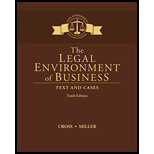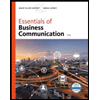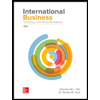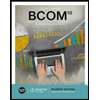
The Legal Environment of Business: Text and Cases (MindTap Course List)
10th Edition
ISBN: 9781305967304
Author: Frank B. Cross, Roger LeRoy Miller
Publisher: Cengage Learning
expand_more
expand_more
format_list_bulleted
Question
Chapter 7, Problem 1CT
Summary Introduction
Case summary: Six-year-old H was given a dose of the DTP vaccine by her pediatrician, under the childhood immunization schedule in accordance with the Centers for Disease Control’s recommendations. The vaccine resulted in seizures within 24 hours of vaccination. The doctor’s diagnosis declared H to be suffering from “residual seizure disorders.” H’s parents filed a lawsuit against the vaccine manufacturer W, claiming recovery on the basis of strict product liability.
To Find:The Expression of the public policy under the provision of NCVIA.
Expert Solution & Answer
Want to see the full answer?
Check out a sample textbook solution
Students have asked these similar questions
Sony Corporation manufactured and sold home video recorders, specifically Betamax videotape recorders (VTRs). Universal City Studios, Inc. (Universal), owned the copyrights on some programs aired on commercially sponsored television. Individual Betamax owners frequently used the device to record some of Universal’s copyrighted television programs for their own noncommercial use. Universal brought suit, claiming that the sale of the Betamax VTRs to the general public violated its rights under the Copyright Act. It sought no relief against any Betamax consumer. Instead, Universal sued Sony for contributory infringement of its copyrights, seeking money damages, an equitable accounting of profits, and an injunction against the manufacture and sale of Betamax VTRs. Explain whether Universal will prevail in its action.
Discuss the Consumer’s Rights as given by President Kennedy
In 1923, DuPont was granted the exclusive right to make and sell cellophane in North America. In 1927, the company introduced a moisture-proof brand of cello- phane that was ideal for various wrapping needs. Although more expensive than most competing wrapping, it offered a desired combination of transparency, strength, and cost. Except for its permeability to gases, however, cellophane had no qualities that a number of competing materials did not possess as well. Cellophane sales increased dramatically, and by 1950, DuPont produced almost 75 percent of the cellophane sold in the United States. Nevertheless, sales of the material constituted less than 20 percent of the sales of “flexible packaging materials.” The United States brought an action, contending that by so dominating cellophane production, DuPont had monopolized a part of trade or commerce in violation of the Sherman Act. DuPont argued that it had not monopolized because it did not have the power to control the price of…
Chapter 7 Solutions
The Legal Environment of Business: Text and Cases (MindTap Course List)
Knowledge Booster
Similar questions
- Vuitton, a French corporation, manufactures high-quality handbags, luggage, and accessories. Crown Handbags,. a New York corporation, manufactures and distributes ladies’ handbags. Vuitton handbags are sold exclusively in expensive department stores, and distribution is strictly controlled to maintain a certain retail selling price. The Vuitton bags bear a registered trademark and a distinctive design. Crown’s handbags appear identical to the Vuitton bags but are of inferior quality. May Vuitton recover from Crown for manufacturing counterfeit handbags and selling them at a discount? Explain.arrow_forward34. Which of the following is derived from statutes? A) Express corporate authority B) Implied corporate authority C) Ultra vires acts D) Exempt actsarrow_forwardBUSINESS LAW 3 - David Ungar holds a Dunkin’ Donut's franchise. The terms of his franchise agreement require him to use only those ingredients furnished by Dunkin’ Donuts. He is also required to buy its napkins, cups, and so on, with the Dunkin’ Donut's trademark on them. Is this an illegal tying arrangement? What if Dunkin’ Donuts maintains that it needs these requirements to maintain its quality levels on a nationwide basis? [Ungar v. Dunkin’ Donuts of America, Inc., 429 U.S 5 - Hines Cosmetic Co. sold beauty preparations nationally to beauty shops at a standard or fixed- price schedule. Some of the shops were also supplied with a free demonstrator and free advertising materials. The shops that were not supplied with them claimed that giving the free services and materials constituted unlawful price discrimination. Hines replied that there was no price discrimination because it charged everyone the same. What it was giving free was merely a promotional campaign that was not…arrow_forward
- The Federal Crop Insurance Corporation (FCIC) was created as a wholly government-owned corporation to insure wheat producers against unavoidable crop failure. As required by law, the FCIC published in the Federal Register conditions for crop insurance. Specifically, the FCIC published that spring wheat reseeded on winter wheat acreage was ineligible for coverage. When farmer Merrill applied for insurance on his wheat crop, he informed the local FCIC agent that 400 of his 460 acres of spring wheat were reseeded on the winter wheat acreage. The agent advised Merrill that his entire crop was insurable. When drought destroyed Merrill’s wheat, Merrill tried to collect the insurance, but the FCIC refused to pay, asserting that Merrill is bound by the notice provided by publication of the regulation in the Federal Register. Is the FCIC correct? Explain.arrow_forwardAs part of its business, Kinko’s Graphics Corporation (Kinko’s) copied excerpts from books, compiled them in “packets,” and sold the packets to college students. Kinko’s did this without permission from the owners of the copyrights to the books and without paying copyright fees or royalties. Kinko’s has more than two hundred stores nationwide and reported $15 million in assets and $3 million in profits for 1989. Basic Books, Harper & Row, John Wiley & Sons, and others (plaintiffs) sued Kinko’s for violation of the Copyright Act of 1976. Plaintiffs owned copyrights to the works copied and sold by Kinko’s and derived substantial income from royalties. They argued that Kinko’s had infringed on their copyrights by copying excerpts from their books and selling the copies to college students for profit. Kinko’s admitted that it had copied excerpts without permission and had sold them in packets to students, but it contended that its actions constituted a fair use of the works in…arrow_forwardANTHEM’S AVOIDABLE EMERGENCY ROOM POLICYAnthem, one of the largest healthcare insurers in the United States, implemented an“avoidable ER” policy to help manage the care of its enrollees. The policy stated thatAnthem would not pay for emergency room visits if the company determined that the visitwas not necessary. The policy, which was instituted in six states beginning in 2015, wasmeant to encourage patients to seek care in appropriate settings. However, providers feelthat this policy might cause patients to avoid emergency treatment, even when it isnecessary. In response to customer and provider complaints, Anthem created severalexceptions: Claims will be covered if a healthcare provider tells a patient to go to theemergency room, if the patient is under 15 years of age, if the patient is outside his or her state of residence, and if the patient had a CT scan or MRI or underwent surgery. Still,providers are unhappy with the policy (Livingston 2018). What other solutions could be used…arrow_forward
- –1- Ali is the owner of a shop. He places a notice on the window advertising the sale of batteries at half price. What kind of notice? –2- Rose & Frank Company was appointed as selling agents in North America by Crompton Brothers by an agreement. One of the clauses in the agreement provided” this agreement is not entered into a formal or legal agreement and shall not be subject to legal jurisdiction in the law courts”. –3- Company Y offers to sell to Company Z “100 tons of oil”. What kind of offer is this? Provide: 1- What kind of contract 2- Legal or not 3- implied or Express or Quasi 4- Unilateral or Bilateral 5- Reflection and commentsarrow_forwardOlga, a resident of Maine, was recently injured by a defective product produced by Home Appliance Corporation, which is incorporated in Delaware but has its company headquarters in Virgina. Olga purchased the defective product in Maine. Olga is suing Home Appliance for $60,000. Which courts would have personal jurisdiction in this case? Would a federal court have jurisdiction? Why or why not?arrow_forward
arrow_back_ios
arrow_forward_ios
Recommended textbooks for you
 BUSN 11 Introduction to Business Student EditionBusinessISBN:9781337407137Author:KellyPublisher:Cengage Learning
BUSN 11 Introduction to Business Student EditionBusinessISBN:9781337407137Author:KellyPublisher:Cengage Learning Essentials of Business Communication (MindTap Cou...BusinessISBN:9781337386494Author:Mary Ellen Guffey, Dana LoewyPublisher:Cengage Learning
Essentials of Business Communication (MindTap Cou...BusinessISBN:9781337386494Author:Mary Ellen Guffey, Dana LoewyPublisher:Cengage Learning Accounting Information Systems (14th Edition)BusinessISBN:9780134474021Author:Marshall B. Romney, Paul J. SteinbartPublisher:PEARSON
Accounting Information Systems (14th Edition)BusinessISBN:9780134474021Author:Marshall B. Romney, Paul J. SteinbartPublisher:PEARSON
 International Business: Competing in the Global M...BusinessISBN:9781259929441Author:Charles W. L. Hill Dr, G. Tomas M. HultPublisher:McGraw-Hill Education
International Business: Competing in the Global M...BusinessISBN:9781259929441Author:Charles W. L. Hill Dr, G. Tomas M. HultPublisher:McGraw-Hill Education

BUSN 11 Introduction to Business Student Edition
Business
ISBN:9781337407137
Author:Kelly
Publisher:Cengage Learning

Essentials of Business Communication (MindTap Cou...
Business
ISBN:9781337386494
Author:Mary Ellen Guffey, Dana Loewy
Publisher:Cengage Learning

Accounting Information Systems (14th Edition)
Business
ISBN:9780134474021
Author:Marshall B. Romney, Paul J. Steinbart
Publisher:PEARSON


International Business: Competing in the Global M...
Business
ISBN:9781259929441
Author:Charles W. L. Hill Dr, G. Tomas M. Hult
Publisher:McGraw-Hill Education
